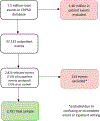What Safety Events Are Reported For Ambulatory Care? Analysis of Incident Reports from a Patient Safety Organization
- PMID: 32980254
- PMCID: PMC7938864
- DOI: 10.1016/j.jcjq.2020.08.010
What Safety Events Are Reported For Ambulatory Care? Analysis of Incident Reports from a Patient Safety Organization
Abstract
Introduction: Health care staff document patient safety events using incident reporting systems, which are compiled within Patient Safety Organization databases. Researchers sought to describe the patterns and characteristics of incident reporting behaviors for ambulatory care from in-situ reporting systems from the United States.
Methods: The team analyzed safety reports in ambulatory settings collected from a Patient Safety Organization comprising 400 hospital members in 10 states, from May 2012 to October 2018. All events involving moderate harm, severe harm, and death were included, as well as subsamples of events with missing harm, no harm, and mild harm. The team deductively coded incident types and if patient or caregiver challenges were involved. A multivariate logistic regression was conducted to identify predictors of higher harm (severe harm and death) among safety events reported.
Results: Of 2,701 events, there were 51 deaths, 159 severe harm events, 1,180 moderate harm, 926 mild harm, 384 no harm, and 1 unknown. Most were from outpatient subspecialty care, while 5.2% were from home/community, and 2.1% were from primary care. Medication-related events were most common (45.3%). In multivariate analysis, diagnostic errors (adjusted odds ratio [aOR] 11.5), patient/caregiver challenges (aOR 2.2), and events in the home/community (aOR 2.0) and in psychiatric settings (aOR 5.0) were associated with higher harm.
Conclusion: Outpatient reporting systems are limited for primary care and home/community settings, but ambulatory care systems report more harmful events related to diagnosis and patient and caregiver challenges. Improved standardization of reporting, focus on diagnosis, and novel approaches of safety reporting that engage patients will be necessary to improve capture of preventable events affecting patients and to develop system-level solutions.
Copyright © 2020. Published by Elsevier Inc.
Figures
References
-
- Shekelle PG, Sarkar U, Shojania K, et al. Patient Safety in Ambulatory Settings. Rockville (MD): Agency for Healthcare Research and Quality (US); 2016. http://www.ncbi.nlm.nih.gov/books/NBK396055/. Accessed December 30, 2019. - PubMed
-
- Organization WH. Safer Primary Care: A Global Challenge. Geneva: World Health Organization; 2012. https://www.who.int/patientsafety/summary_report_of_primary_care_consult....
-
- Kohn L, Corrigan J, Donaldson M, eds. To Err Is Human: Building a Safer Health System. Washington (DC): National Academies Press (US); 2000. http://www.ncbi.nlm.nih.gov/books/NBK225182/. Accessed December 30, 2019. - PubMed
Grants and funding
LinkOut - more resources
Full Text Sources
Other Literature Sources



